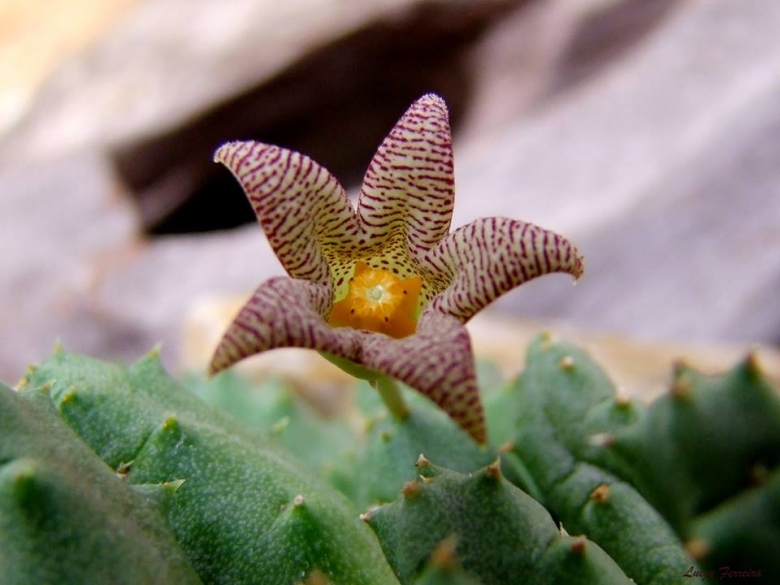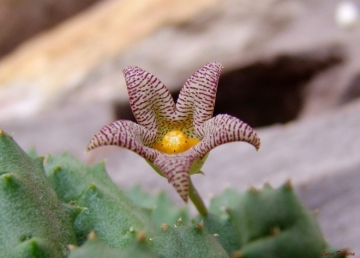Accepted Scientific Name: Piaranthus punctatus var. framesii (Pillans) Bruyns
Stapeliads S. Africa Madagascar 2: 355 (2005) Bruyns

Piaranthus framesii (Piaranthus punctatus var. framesii) Photo by: Luiza Ferreira
PUB 4328
Origin and Habitat: Republic of South Africa (Northern Cape, Western Cape); Karoo.
Altitude range: 500 - 1100 metres above sea level.
Habitat and ecology: From the same mountain Karoo area as Piaranthus decorusSN|29232]]SN|18048]], the small, rounded joints of Piaranthus framesiiSN|29238]]SN|29238]] grow, interlocked with the stems of shrubs, as usually seen with most members of the Stapelieae. In contrast, the closely related Piaranthus punctatusSN|18048]]SN|29232]] prefers the lower areas of the Namaqualand Succulent Karoo. Recent collections are also indicative of the presence of hybrid populations.
Synonyms:
See all synonyms of Piaranthus punctatus
back
Accepted name in llifle Database:Piaranthus punctatus (Masson) R.Br. ex Schult.Mem. Wern. Nat. Hist. Soc 1: 23 (1810)Synonymy: 6
Accepted name in llifle Database:Piaranthus punctatus var. framesii (Pillans) BruynsStapeliads S. Africa Madagascar 2: 355 (2005)Synonymy: 2
back
Description: Piaranthus punctatusSN|29232]]SN|29232]] var. framesii (Piaranthus framesiiSN|29238]]SN|29238]]) is a distinct stapeliad characterized by bell shaped flowers of elaborate design and beauty, and unlike the closely related Piaranthus punctatusSN|29232]]SN|29232]] has papillae on the corolla instead of hairs and typically winged corona. The flowers are numerous and open simultaneously or with long intervals in late Summer or Autumn.
Stems: 1 - 5 (-9) x 1 - 2 (-2.5) cm, ovoid to cylindrical, compact, slightly rough.
Inflorescence: 1- to several-flowered; Peduncle 8-20 mm long, 1.5-2 mm in diameter.
Flower: Inodorous or honey-scented. Sepals 2-4 mm long. Corolla 17-23 mm in diameter, united in the central half. Corolla tube bell-shaped, 5 -8 mm across, 4 - 7 mm high, more or less pentagonal. Corolla-lobes 6.5-9 long, 4-6 mm wide, basally depressed, white to ivory-coloured with reddish patches or transverse bands, papillose, papillae globose, 0.1 mm. Corona 4-5.5 x 4.5-5.5 mm, barrel-shaped, winged in staminal position. Outer corona lobes 0.5-1.5 x 0.5 mm, linear-subulate, entire, crooking over the backs of the Anthers, crest absent. Style head free. Pollinia 0.6-0.7 x 0.35 mm.
Fruits (follicles): Approx 10 cm long.
Seeds: Approx. 5 x 2.5 mm.
Subspecies, varieties, forms and cultivars of plants belonging to the Piaranthus punctatus group
 Piaranthus punctatus (Masson) R.Br. ex Schult.: has ivory-coloured corolla with reddish or brown patches or transverse bands; the upper side has fine, papillous warts. Distribution: lower areas of the Namaqualand Succulent Karoo.
Piaranthus punctatus (Masson) R.Br. ex Schult.: has ivory-coloured corolla with reddish or brown patches or transverse bands; the upper side has fine, papillous warts. Distribution: lower areas of the Namaqualand Succulent Karoo. Piaranthus punctatus var. framesii (Pillans) Bruyns: has papillae on the corolla instead of hairs and typically winged corona. Distribution: Higher areas of the Namaqualand Succulent Karoo.
Piaranthus punctatus var. framesii (Pillans) Bruyns: has papillae on the corolla instead of hairs and typically winged corona. Distribution: Higher areas of the Namaqualand Succulent Karoo.
Bibliography: Major references and further lectures
1) Focke Albers, Ulrich Meve “Illustrated Handbook of Succulent Plants: Asclepiadaceae: Asclepiadaceae” Volume 4 Springer, 2002
2) Werner Rauh “The Wonderful World of Succulents: Cultivation and Description of Selected Succulent Plants Other Than Cacti” Smithsonian Institution Press, 1984
3) Hermann Jacobsen “A handbook of succulent plants: descriptions, synonyms, and cultural details for succulents other than Cactaceae” Volume 1 Blandford Press, 1960
4) ) James Cullen, Sabina G. Knees, H. Suzanne Cubey “The European Garden Flora Flowering Plants: A Manual for the Identification of Plants Cultivated in Europe, Both Out-of-Doors and Under Glass” Cambridge University Press, 11/August/2011
5) Doreen Court “Succulent Flora of Southern Africa” CRC Press, 01/June/2000
 PUB 4328 (Piaranthus punctatus var. framesii) Photo by: Luiza Ferreira
PUB 4328 (Piaranthus punctatus var. framesii) Photo by: Luiza FerreiraSend a photo of this plant.The gallery now contains thousands of pictures, however it is possible to do even more. We are, of course, seeking photos of species not yet shown in the gallery but not only that, we are also looking for better pictures than those already present.
Read More... Cultivation and Propagation: Piaranthus framesiiSN|29238]]SN|29238]] is an easy obliging blooming plant, which is happy in any average succulent house. This plant is common to warrant any description, let it suffice to say that this plant is easy to grow and flower, and one which will tolerate most soils and growing conditions.
Soil: Since roots are quite shallow, use a cactus mix or add extra perlite or pumice to regular soil potting soil. A gritty, very free-draining compost is suitable, and clay pots help the plants to dry out between watering.
Watering: They require moderately watering through the growing season but enjoy plenty of water and some fertiliser in hot weather, this helps them to flower freely. Water more sparingly in winter according to temperatures. But, as with most asclepiads, it is unwise to leave them wet in cold weather.
Hardiness: Winter care presents no problems at 5°C with plenty of light.
Sun Exposure: Partial sun or light shade.
Pest and diseases: They are generally fairly easy to grow, especially if kept pest-free. They are susceptible to stem and root mealy bugs, and damage from these may well initiate fungal attack. If you do have problems with a stem or with basal rotting, you can reliably isolate the healthy parts, dry them off, and re-root them in moist compost.
Cultural Practices: Re-pot every 2 years.
Propagation: Easiest with stem cuttings. Allow cuttings to dry a day before planting. Stems must be laid (Not buried) on gritty compost and will then root from the underside of the stems. It can also be increased from seeds sowing in spring in moist, sandy peat moss. Barely cover seeds.












